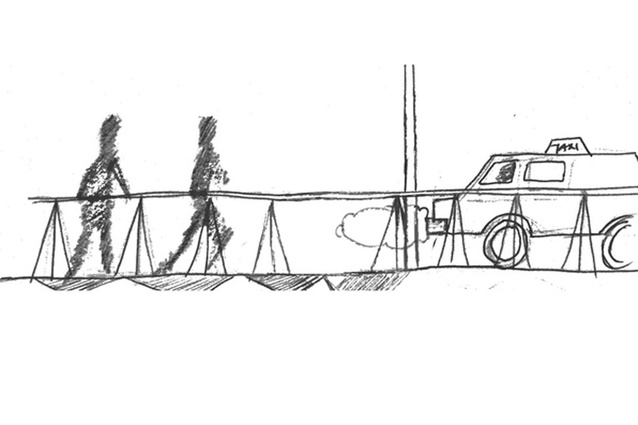Wellington’s flyover
The New Zealand Transport Agency’s Basin Bridge (flyover) proposal for a $90-million overbridge across Wellington’s Basin Reserve, an oft-congested roundabout near the Mount Victoria tunnel, has been hugely contentious. Recently, an independent Board of Inquiry denied it resource consent because of the adverse effects it would have on ‘the urban area’s heritage,
function and appearance’. Local architect Guy Marriage asks, “If a flyover is not the answer, then what was the question?”
The Board of Inquiry spent considerable time over its 72-day-long sojourn, looking at the history of what the actual design brief was for Wellington’s flyover. Was the initial question: “How do we speed up traffic to the airport?” Or was the question: “How do we create a successful multi-modal transport solution across a junction on a major Public Transport Spine route?” Or was the question a more knotty: “How do we build a flyover and get it approved by the Basin Reserve cricketers, who would otherwise be bound to say ‘No’?”
Other questions could be aimed at issues like: “What is the solution to picking up school children from three different schools on the site of a major traffic roundabout?” Or even the innocuous: “How do you walk or ride a bike north-south across a cricket ground, when that conflicts with traffic flowing predominantly east-west?” These are, as I think you might agree, all rather different questions and so, of course, all receive rather different answers and, hence, different solutions. It is not surprising, therefore, that the one given answer, a flyover, does not satisfy all those questions nor does its rejection solve the questions either.
One of the key points that the New Zealand Transport Agency (NZTA) stumbled upon was the integration of the project with the Public Transport (PT) ‘Spine Study’. Let’s be perfectly honest about this – the PT Spine is of crucial importance to the continued growth of Wellington and a flyover would help that by grade separating this awkward junction. NZTA relied upon this need for grade separation but never really engaged with how Public Transport would work through here – more or less saying, “We will provide a bridge over, now you plan out your PT Spine under – our job here is done”. Understandably, that did not go down well with either the public or the Commissioners, neither did it answer the key parts of any of the questions above. Efforts to address the multi-modal part of the question were answered by proposing to stick on a bike lane along the northern side of the flyover. However, the fact that this would not be protected from the wind, was not on the public’s cycling desire line (running completely perpendicular to the desired direction of travel) and would, in all reality, never be used until a second Mt Victoria tunnel was built several years hence, meant that the NZTA’s proposals really did not treat the needs and wants of the non-motoring public at all.
Nor, in fact, does the NZTA solution treat the needs of the motoring public either. The Inquiry rooted out from the masses of (dis)information provided that the Basin Bridge would have an almost completely zero effect on reducing time driving to the airport (a point that detractors of the decision still do not seem to understand), while also having only a negligible effect of reducing time driving from the airport. The scheme, as it stands, does not actually work on its own and needs to be designed in conjunction with the second tunnel through Mt Vic for it to have any noticeable effect on traffic times but, even then, traffic would just be snarled up at the next set of lights. Seriously: the flyover is not a traffic solution for airport traffic at all.
NZTA’s project downfall was that integrating an underpass beneath Memorial Park was always put in the ‘too-hard’ basket, until too late. They promised that, in the unlikely event of the Government actually ever giving this idea the go-ahead, alternative schemes like Option F and Option X would, of course, be reconsidered. Considerable time was spent examining the recorded time lines of what consultation happened, and why additional re-examination of alternatives did or did not happen. Arguably, given the size of the change in the situation, when the Government actually did give the go-ahead to an underground tunnel (necessitating a speedy and highly controversial Act of Parliament to be pushed through overnight), the whole Basin Reserve crossing should have been thrown back open and started again. With the cost of this underpass now sitting at well over $100 million, it does not take a genius to understand that this amount could now be taken off the cost of other schemes, therefore making them considerably more affordable than is a 265m-long concrete bridge across a swamp.
But, in the end, none of this discussion really matters. The Board could examine only whether the official application by NZTA of the Option A flyover/concrete Basin Bridge had fairly evaluated the other options. It found the process wanting. The Option A bridge across the north of the Basin was the wrong answer to any number of wrong questions. The NZTA bridge, as designed, runs parallel and above the existing State Highway, twisting awkwardly to avoid clashing with neighbouring buildings. While NZTA kept dogmatically saying that grade separation was the only way to resolve the twice-daily traffic snarls (that really occur only during school term time), they never actually said why a $100-million concrete bridge, fully one-quarter-of-a-kilometre long, was necessary to cross one relatively small 13m-wide arterial road. It is not beyond the realms of possibility that a solution could be found to provide grade separation and at a far lower cost.










